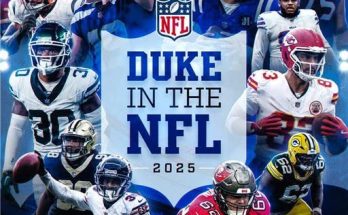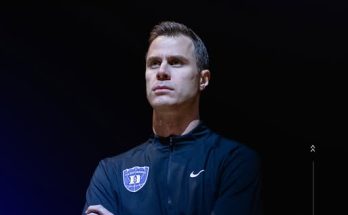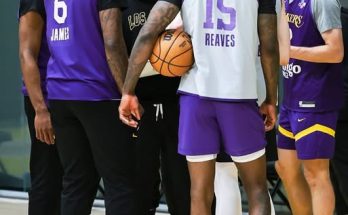In a stunning development that has sent ripples through the college football world, the top five-star quarterback prospect in the nation has defied expectations, choosing LSU over the heavily favored Alabama Crimson Tide. This commitment marks one of the most shocking recruiting twists in recent memory, a seismic shift with implications that stretch far beyond the SEC. For LSU, it is a monumental victory that reaffirms the program’s national relevance and provides the kind of momentum capable of reshaping the college football landscape. For Alabama, it is a rare recruiting miss at the quarterback position—one that stings not just because of the player’s elite talent, but because of how close the Tide appeared to securing him.
The quarterback, whose blend of athleticism, arm strength, football IQ, and poise has drawn comparisons to generational talents like Patrick Mahomes and Caleb Williams, had been widely projected to commit to Alabama for months. The Crimson Tide’s coaching staff had prioritized him early, and his multiple visits to Tuscaloosa, warm relationship with the staff, and public admiration for the Alabama brand all pointed toward a future in crimson and white. Recruiting analysts, insiders, and fans alike assumed it was a done deal. But as it turns out, nothing in recruiting is ever certain until the paperwork is signed—and in this case, LSU emerged as the last-minute victor in a high-stakes battle that could define the next several seasons of college football.
Sources close to the quarterback’s camp suggest that the decision came down to more than just football. While Alabama’s pedigree and winning tradition were clearly appealing, LSU’s pitch centered around immediate impact, offensive freedom, and building a legacy as the face of a rising program. LSU head coach Brian Kelly, alongside his offensive staff, reportedly emphasized the opportunity to be the leader of a dynamic, quarterback-friendly offense tailored to the prospect’s strengths. More importantly, they framed LSU not as a place where he would merely follow in someone else’s footsteps—but as a canvas where he could paint his own masterpiece.
That message resonated. The quarterback, mature beyond his years, reportedly took his time evaluating the depth charts, offensive schemes, and long-term vision of each program. Though Alabama offered stability and a championship pedigree, LSU offered the allure of something more personal—something transformative. And in the end, it was the chance to be the centerpiece of a movement rather than just another name in a legacy that swayed him.
The impact of this commitment cannot be overstated. With this pledge, LSU adds a generational player who could redefine the program’s trajectory. The 6-foot-4, 215-pound signal-caller possesses the kind of dual-threat versatility that modern offenses crave. He can make every throw in the book—deep balls down the sideline, lasers over the middle, and touch passes on the run. He’s equally dangerous with his legs, capable of turning broken plays into highlight-reel touchdowns. Perhaps most impressively, he brings an elite football intellect to the position, routinely diagnosing defenses pre-snap and adjusting protections like a seasoned veteran.
From a pure football standpoint, this is the kind of recruit who can elevate a program from good to great. But the implications extend further. In today’s NIL-driven recruiting world, a commitment like this is also a massive branding win. LSU has positioned itself as a forward-thinking program—one that supports its athletes on and off the field. While the specifics of any NIL arrangements are not public, sources suggest that LSU’s holistic approach to development, visibility, and long-term earning potential was a key factor in sealing the deal.
For Alabama, this development raises uncomfortable questions. Though still among the most dominant programs in the country, the Tide have recently experienced some turbulence in recruiting, especially at the quarterback position. While the program continues to attract top-tier talent, this particular loss feels like more than a blip. It signals the increasing competitiveness of the recruiting landscape, where even Alabama’s unparalleled success can no longer guarantee every top commitment.
This is especially notable given the recent transition in coaching leadership. With longtime head coach Nick Saban retiring and his successor—former defensive coordinator Glenn Schumann—stepping into the spotlight, there’s a sense that the aura of invincibility surrounding Alabama may be showing cracks. Schumann has earned respect throughout the sport, but following a legend is never easy. And when a recruit of this caliber chooses a division rival over you, it raises the stakes for every future recruiting cycle.
Moreover, the ripple effect of this commitment could be felt across the SEC. LSU now becomes a far more attractive destination for other elite offensive prospects—wide receivers, offensive linemen, running backs—who want to play alongside a generational quarterback talent. Recruiting is often a domino game, and this commitment could spark a wave of others that further tip the balance of power.
There’s also the national perspective to consider. With the expanded College Football Playoff format beginning next season, having a quarterback of this caliber makes LSU an immediate threat to contend not just for SEC titles, but for national championships. The Tigers already possess a strong roster, bolstered by recent recruiting wins and solid development. Adding a quarterback capable of transcending schemes and carrying a team in big moments could make LSU a legitimate playoff staple for years to come.
This commitment also underscores the evolving landscape of college football—a sport increasingly defined by bold decisions, branding battles, and the power of personality. Today’s top recruits are not just looking at tradition or facilities. They want a voice, a platform, and a roadmap to the NFL. LSU, in this case, managed to check every box while appealing to the individualism and ambition of an elite quarterback prospect.
In the coming months, attention will shift to how LSU plans to build around their new star. Expect the Tigers to tailor their offensive system to maximize his strengths, much like programs have done in the past with players like Joe Burrow, Kyler Murray, or Trevor Lawrence. And while the quarterback still has one more year of high school football to play, LSU fans will already be counting down the days until he arrives in Baton Rouge.
This moment also serves as a reminder that the power dynamics in college football are always shifting. For years, Alabama’s dominance was so unquestioned that a miss like this would have seemed impossible. But in today’s game, with the right vision, pitch, and momentum, programs like LSU can swing big—and win. And in this case, they didn’t just win a commitment. They may have changed the entire arc of their future.
Only time will tell how this decision plays out. Recruiting is never a guarantee, and the transition to college football is never easy, even for the most talented players. But if this quarterback lives up to the hype—and all signs suggest he will—then LSU just secured one of the most important building blocks in the modern era of their program.
For now, the message is clear: LSU is back in the business of chasing greatness. With a superstar quarterback now in the fold and the recruiting momentum of a freight train, the Tigers are no longer just contenders—they’re aiming to dominate. And for Alabama, this loss is a reminder that in a sport defined by razor-thin margins, even the kings can bleed.
You said:
ChatGPT said:
Catching greatness is not something that happens overnight. It’s not earned through flashy highlights or viral clips—it’s forged in the quiet hours, in the weight room before sunrise, behind the plate on muggy spring afternoons, and in the dugout with dirt-streaked pants and a mind always one pitch ahead. For Rylan Galvan, the journey to becoming the nation’s best catcher has been one of grit, evolution, and unrelenting excellence. Today, that journey has reached a defining milestone: Rylan Galvan has officially been crowned the top catcher in the country.
For those who have followed his trajectory, the accolade comes as no surprise. Galvan, a cornerstone of one of the most consistent and respected programs in college baseball, has spent the past few seasons redefining what it means to be an elite backstop in the modern game. While many catchers are praised for either their defensive prowess or their offensive output, Galvan is the rare player who dominates both facets with equal intensity. He is the gold standard, the prototype, and now, the undisputed best behind the plate.
What separates Galvan from the pack is not just his physical tools, though those are considerable. At 6-foot-1 and 200 pounds, he’s built like a linebacker, but moves with the fluidity and agility of a shortstop. His pop time—how quickly he can receive a pitch and fire it to second base—is elite, routinely clocked at under 1.9 seconds. His arm strength is matched only by his accuracy, gunning down would-be base stealers with surgical precision. But it’s not just the metrics that elevate Galvan—it’s the presence. When he’s behind the dish, pitchers feel invincible. His leadership, framing ability, and feel for the game turn good pitching staffs into dominant ones.
Coaches rave about his maturity. Teammates talk about his intensity. Opponents groan about how difficult it is to game-plan against him. It’s rare to find a catcher who can control the tempo of an entire game, but that’s what Galvan does on a routine basis. He’s more than just a battery mate—he’s the engine that drives his team’s success.
Offensively, Galvan has transformed himself from a steady contributor to a middle-of-the-order nightmare. He’s hitting for average, power, and situational efficiency, displaying plate discipline that forces pitchers into uncomfortable counts. His swing is compact and explosive, capable of turning around high-velocity fastballs or driving breaking balls into the gap. Whether it’s a two-strike count with the bases loaded or a bunt to move a runner over, Galvan’s approach is always team-first—but the results tend to be spectacular regardless.
This season, Galvan has put up numbers that rival some of the best all-time collegiate seasons by a catcher. He’s batting well over .340 with double-digit home runs, a slugging percentage north of .600, and an on-base percentage that underscores his elite plate discipline. Yet, what truly defines his campaign is the consistency. There are no cold stretches, no off-weeks—just a steady drumbeat of production and poise.
Beyond the numbers, what cements Galvan’s place atop the catcher hierarchy is the way he elevates everyone around him. Baseball is a game of subtle adjustments, mental endurance, and emotional control, and few players exemplify those qualities better than Galvan. When the stakes are highest, he becomes the calm in the storm. He’s the player pitchers look to for reassurance, the guy who holds post-game meetings when things don’t go right, and the one who celebrates teammates’ success more than his own.
The mental grind of catching is often overlooked. There’s a reason catchers are called the field generals. They’re involved in every pitch, constantly processing pitch sequences, batter tendencies, and base-running threats. They block 95-mph sliders in the dirt and still find the energy to leg out extra-base hits. Galvan thrives in this chaos. He loves the responsibility. He prepares obsessively, pouring over film, scouting reports, and bullpen sessions like a coach in cleats. It’s this cerebral side that sets him apart and makes him invaluable.
It’s also worth noting that Galvan’s path hasn’t always been smooth. Early in his collegiate career, he had to battle through injuries, manage the pressure of expectations, and adjust to the speed of the college game. But each challenge became fuel. Instead of shrinking under the spotlight, Galvan used adversity to sharpen his edge. Those who know him best say his competitiveness is unmatched—not in a loud, brash way, but in a relentless, surgical kind of way. He plays like every pitch matters because to him, it does.



